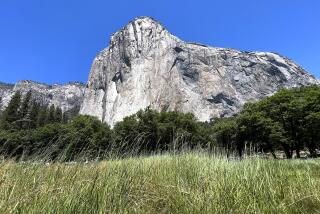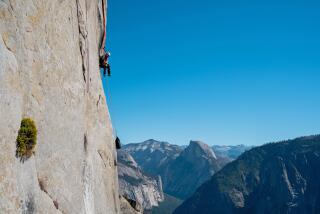Sir Edmund Hillary, 1st to scale Mt. Everest, dies
Sir Edmund Hillary, the mountain-climbing New Zealand beekeeper who became a mid-20th century hero as the first person to reach the summit of Mount Everest, has died. He was 88.
Hillary, who made his historic climb to the top of the world’s highest mountain with Sherpa mountaineer Tenzing Norgay of Nepal, died Friday, according to an announcement from the office of New Zealand’s prime minister Helen Clark. The cause and place of death were not immediately reported.
Eight previous British expeditions had failed to reach the top of the 29,017-foot peak and a number of expedition members had died in the process, most famously climbing partners George Mallory and Andrew Irvine who disappeared on Everest in 1924.
But at 11:30 a.m. on May 29, 1953, Hillary and Tenzing made it to the top of the world.
Hillary’s first words, to fellow climber George Lowe, when he and Tenzing returned from the summit were, “Well, George, we knocked the bastard off!”
Word of the British Everest expedition’s success reached England the night before the coronation of Elizabeth II, resulting in a memorable newspaper headline the next morning: “All this and Everest too!”
Hillary and John Hunt, the British Army colonel who led the Everest expedition, were knighted by Queen Elizabeth; and Tenzing received the George Medal, the second-highest award for gallantry that can be given to a civilian.
Hailed as one of the 20th century’s great adventurers, the 33-year-old Hillary became one of the most famous men alive, with his long, rugged face appearing on everything from magazine covers to postage stamps.
The tall and lean Hillary never expected to become a world-renowned celebrity.
“I was a bit naive, really,” he told the Detroit Free Press in 2000. “I was just a country boy. I thought the mountaineering world would be interested, but I never dreamed that it would have that effect on people who didn’t climb.”
And, he maintained, he never regarded himself as a hero.
“I was a mountaineer who worked to reach the summits of mountains,” he told USA Today in 1998. “Even in my 79th year, I don’t believe a word of the rubbish printed over the years.’
In 1985, he became New Zealand High Commissioner (ambassador) to India and was based in New Delhi for the several years.
But along with the triumphs came tragedy.
In 1975, Hillary’s first wife, Louise, and their 16-year-old daughter, Belinda, were killed when the single-engine plane they were flying in crashed on takeoff at the airport in Katmandu.
In 1989, he married June Mulgrew, a longtime family friend and widow of fellow mountaineer Peter Mulgrew, who had taken Hillary’s place as a commentator on a 1979 Antarctic sightseeing flight and died when the plane crashed.
Over the years, Hillary served as a camping equipment advisor for Sears Roebuck, lectured widely and wrote a number of books, including “High Adventure,” “The Crossing of Antarctica,” “No Latitude for Error,” “From the Ocean to the Sky,” “Nothing Venture, Nothing Win” and “View from the Summit.”
Over the past four decades, Hillary spent much of his time raising funds for the Himalayan Trust. He founded the nonprofit organization in 1961 as a way to give back to the Sherpas, one of the many ethnic groups native to Nepal, who served as guides for Western expeditions in the Himalayas.
By 2006, the Trust had built 27 schools, two hospitals and 13 village health clinics, in addition to rebuilding bridges, constructing drinking water systems and providing student scholarships, among other projects.
“Nothing in life can be more satisfying than being the first,” Hillary reflected in 2000, “but what I’m proudest of is my work in the Himalayas.”
The middle of three children, Hillary was born July 20, 1919 in Auckland, New Zealand. His father ran a small weekly newspaper in the country town of Tuakau, where the family lived on seven acres that included a half-dozen cows, a large vegetable garden and orchards. Hillary’s father’s hobby was beekeeping, and he eventually abandoned journalism to run what had become a profitable commercial beekeeping enterprise.
Introverted and bookish, Hillary did so well in grammar school that he skipped two grades. But the gawky boy who would one day conquer Everest was shorter and weaker than his classmates in junior high school. Inept at sports and gymnastics, he suffered hazing from both his classmates and his athletics teacher.
Intending to become an engineer, he entered the University of Auckland. But, he later said, his found it difficult to adapt and lacked interest, so he dropped out after two years and went to work in his father’s thriving beekeeping business.
Hillary, who first saw snow at 16 when he went on a school skiing trip to Mt. Ruapehu on New Zealand’s North Island, began climbing four years later when he, a friend and a guide climbed a small peak near a resort on the South Island.
In 1944, he was called up for service in the Royal New Zealand Air Force and flew on Catalina flying boats in search and rescue operations in Fiji.
After the war, he returned to climbing and scaled New Zealand’s snow-covered, 12,349-foot Mount Cook, which he later described as “the ambition of all local climbers.”
“I knew right away that this is what I wanted to do, spend my life among the mountains and the snow and the ice,” he told the Detroit Free Press in 2000. “I had never been happier in my life, and I couldn’t wait to do it again.”
Tenzing died of a lung infection in 1986 at 72.
In addition to his wife, Hillary is survived by his children Peter and Sarah and several grandchildren.
More to Read
Sign up for The Wild
We’ll help you find the best places to hike, bike and run, as well as the perfect silent spots for meditation and yoga.
You may occasionally receive promotional content from the Los Angeles Times.






